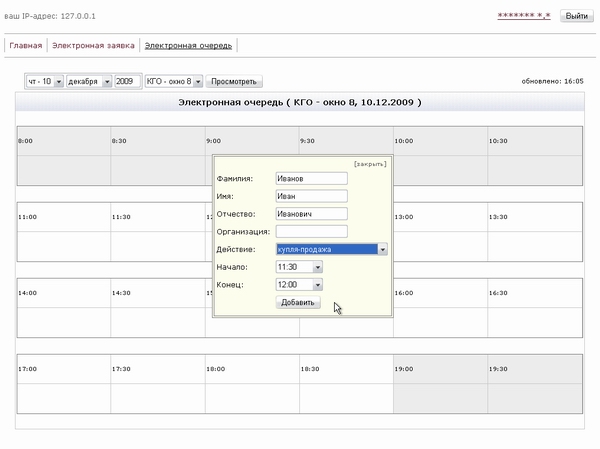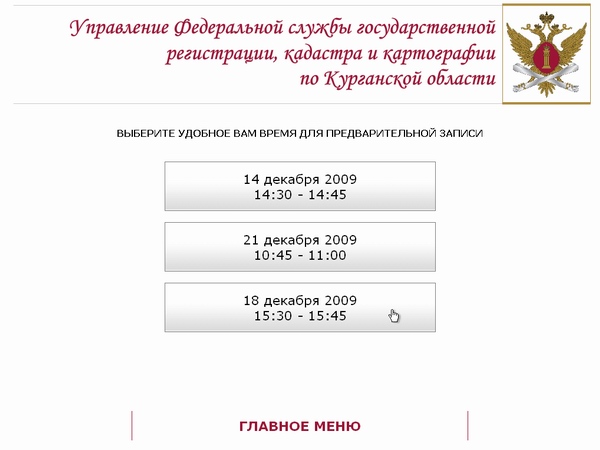Reception of citizens: the experience of the introduction of "electronic queue" (part 2)
Good afternoon dear friends!
Three months have passed since my previous note about how we implemented an “electronic queue” in our Office for the reception of citizens. For three months the next large amount of work has been done. First, of course, running-in and “file completion” of the entire system in “combat conditions”. And, secondly - just recently, a system was launched for independent (!!) recording of applicants in the queue. Read about all these "goodies" under the cut. In addition, for all those interested, I prepared a video presentation that allows live to see how it all works.
Results for three months
')
All three months that have passed since the launch, the system is actively used. The volume of records for each day fluctuates around 80-90%, that is, only 3-4 cells remain free. As indicated in the comments to my previous article, this is useful if there are shifts in the schedule of applicants in time - free cells allow you to return it to normal mode. In addition, as far as possible, experts record applicants "through one" cell - for the same reason.
About a month ago, the use of the system began in another department. Of course, each department has its own nuances, but the backbone of the system, made at the very beginning, remains unchanged. As required, additional fields are simply entered in the database tables and scripts are updated. In general, all specialists using the system note its great convenience in comparison with the paper versions.

During the discussion, another rationalization proposal was implemented - the possibility for the heads of departments to see which of the specialists is conducting a preliminary recording on which day. Potentially, this should exclude the possibility of recording “on shit” from your workplace (bypassing the responsible specialist on a given day).
Self enrollment of applicants
All that has been described above is a preliminary record either by telephone or during a personal visit of a citizen. However, progress is underway, and we are ripe to allow people to sign up for a queue on their own (!!).
As usual, we first run all the innovations on our information and reference terminal (which stands in the reception hall), and only then we introduce them on the site. Thus, it is possible to think over all the risks and pitfalls in advance. And there are enough risks here. For example, "jokers" who will introduce non-existent people. Or realtors who score all the days with their clients.
For the terminal, such problems (not completely, but for the most part) can be solved by installing a 15-minute timer. It is unlikely that anyone would want to “hang out” near the terminal in order to introduce one person every 15 minutes. On the other hand, pre-recording on the terminal is not used so often that someone who accidentally calls in will find a recording lock.
In general, after weighing all the pros and cons, I began to write scripts.
How it all works (a look from the inside)
In my opinion, the most interesting was the writing of a script that defines free cells for writing. If a person, looking at a table, easily understands where to insert a record, how can this be explained to a computer? I had to think of the following algorithm:
- we take all days that are 4-12 days ahead from the current date
- for each day we calculate free time (taking into account lunch, pre-holiday days and already occupied cells)
- as a result of sorting we select the three most free days
- Now the most interesting thing: we run through all the free cells in these days and select the most suitable ones. The best ones are those that are on the left And on the right have another empty cell. The good ones are those that have at least one empty cell on the left OR on the right. Here, the algorithm works according to the same principle that a live person records (recording “through one” cell). If there is neither one nor the other, we search among ordinary cells.
- Whew! selected the three most suitable cells for recording. We offer them to the applicant:

The applicant chooses the most convenient for him and proceeds to fill in their data. A virtual keyboard was developed here:

Finally, if everything is correct, a confirmation is displayed that the data has been received (here they are transferred to a remote server, where they are stored in the database). I think the system is quite simple and intuitive.
findings
Of course, the scripts turned out to be difficult, and I had to spend more than one week running them. Nonetheless, this is another step towards the full electronic service for applicants. Now, already on the basis of the available scripts, it will be possible to undertake the development of a preliminary recording through the website of the Office. We sincerely hope that this system will be useful.
PS Tasty dessert in the end :-): a video presentation of the system, showing in real time everything I described in the article - video file in the archive (14 MB).
Thanks in advance for the comments.
link to kriorazum.ru
link to druzhkov.name
Three months have passed since my previous note about how we implemented an “electronic queue” in our Office for the reception of citizens. For three months the next large amount of work has been done. First, of course, running-in and “file completion” of the entire system in “combat conditions”. And, secondly - just recently, a system was launched for independent (!!) recording of applicants in the queue. Read about all these "goodies" under the cut. In addition, for all those interested, I prepared a video presentation that allows live to see how it all works.
Results for three months
')
All three months that have passed since the launch, the system is actively used. The volume of records for each day fluctuates around 80-90%, that is, only 3-4 cells remain free. As indicated in the comments to my previous article, this is useful if there are shifts in the schedule of applicants in time - free cells allow you to return it to normal mode. In addition, as far as possible, experts record applicants "through one" cell - for the same reason.
About a month ago, the use of the system began in another department. Of course, each department has its own nuances, but the backbone of the system, made at the very beginning, remains unchanged. As required, additional fields are simply entered in the database tables and scripts are updated. In general, all specialists using the system note its great convenience in comparison with the paper versions.

During the discussion, another rationalization proposal was implemented - the possibility for the heads of departments to see which of the specialists is conducting a preliminary recording on which day. Potentially, this should exclude the possibility of recording “on shit” from your workplace (bypassing the responsible specialist on a given day).
Self enrollment of applicants
All that has been described above is a preliminary record either by telephone or during a personal visit of a citizen. However, progress is underway, and we are ripe to allow people to sign up for a queue on their own (!!).
As usual, we first run all the innovations on our information and reference terminal (which stands in the reception hall), and only then we introduce them on the site. Thus, it is possible to think over all the risks and pitfalls in advance. And there are enough risks here. For example, "jokers" who will introduce non-existent people. Or realtors who score all the days with their clients.
For the terminal, such problems (not completely, but for the most part) can be solved by installing a 15-minute timer. It is unlikely that anyone would want to “hang out” near the terminal in order to introduce one person every 15 minutes. On the other hand, pre-recording on the terminal is not used so often that someone who accidentally calls in will find a recording lock.
In general, after weighing all the pros and cons, I began to write scripts.
How it all works (a look from the inside)
In my opinion, the most interesting was the writing of a script that defines free cells for writing. If a person, looking at a table, easily understands where to insert a record, how can this be explained to a computer? I had to think of the following algorithm:
- we take all days that are 4-12 days ahead from the current date
- for each day we calculate free time (taking into account lunch, pre-holiday days and already occupied cells)
- as a result of sorting we select the three most free days
- Now the most interesting thing: we run through all the free cells in these days and select the most suitable ones. The best ones are those that are on the left And on the right have another empty cell. The good ones are those that have at least one empty cell on the left OR on the right. Here, the algorithm works according to the same principle that a live person records (recording “through one” cell). If there is neither one nor the other, we search among ordinary cells.
- Whew! selected the three most suitable cells for recording. We offer them to the applicant:

The applicant chooses the most convenient for him and proceeds to fill in their data. A virtual keyboard was developed here:

Finally, if everything is correct, a confirmation is displayed that the data has been received (here they are transferred to a remote server, where they are stored in the database). I think the system is quite simple and intuitive.
findings
Of course, the scripts turned out to be difficult, and I had to spend more than one week running them. Nonetheless, this is another step towards the full electronic service for applicants. Now, already on the basis of the available scripts, it will be possible to undertake the development of a preliminary recording through the website of the Office. We sincerely hope that this system will be useful.
PS Tasty dessert in the end :-): a video presentation of the system, showing in real time everything I described in the article - video file in the archive (14 MB).
Thanks in advance for the comments.
link to kriorazum.ru
link to druzhkov.name
Source: https://habr.com/ru/post/78182/
All Articles